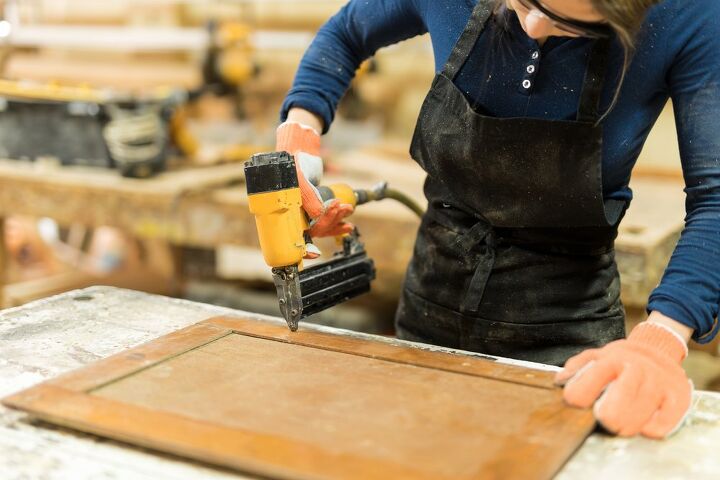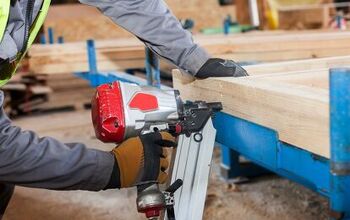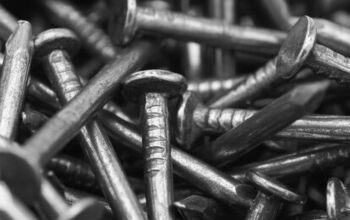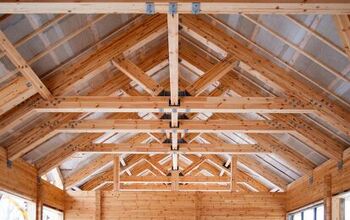Framing Nailer Vs. Finish Nailer: What Are The Major Differences?

Nail guns are excellent tools for producing a quality job in less time. There are two main types of nail guns to consider – framing nailers and finish nailers. What are the differences, and how do you know which is best for a particular job?
The primary difference between a framing nailer and finish nailer is the size of the nails. Framing nailers use larger diameter nails, and finish nailers use smaller diameter nails. The larger the diameter, the stronger the nail. Use a framing nailer for jobs that require solid construction, such as framing. Use a finish nailer for trim and other decorative materials.
Let’s get into some detail about framing nailers and finish nailers, as well as the types of nails that you can use for each tool.
Do You Need to Hire a Framing Contractor?
Get free, zero-commitment quotes from pro contractors near you.

What are Framing Nailers and Finish Nailers?
Framing nailers and finish nailers are two types of nail guns. A nail gun holds a magazine of nails that are held together by plastic strips, coils, or paper strips. When you pull the trigger of a nail gun, a single nail is driven into the wood or other building material. The nail gun automatically loads the next nail into the chamber.
What is a Clipped Head Framing Nailer?
A clipped head framing nailer uses strips of nails that have part of the head removed. The benefit is that you get more nails per strip. The downside is that clipped head nails are more likely to come loose. For this reason, clipped head nails don’t comply with most building codes.
Nail Sizes for Framing and Finish Nailers
The primary difference between a framing nailer and finish nailer is the size of the nails that work with the tool. Framing nail guns work with larger nails between 8 gauge and 11 1/2 gauge. A finish nailer works with smaller nails between 14 gauge and 16 gauge.
Nail Sizing
When you look for nails to use for your construction project, you’ll come across a variety of sizing labels, such as inches, gauge, and penny. Further confusing the matter is shank diameter, shank length, and head diameter. When a nail gun is rated as working with specific gauge of nails, this refers to the diameter of the shank. A lower gauge means that the nail has a larger diameter. Nails with larger diameters are stronger.
Framing nailers work with nails that have shank diameters between 0.162” (8 gauge) and 0.113” (11 1/2 gauge). A finish nailer works with nails that have shank diameters between 0.0625” (14 gauge) and 0.083” (16 gauge).
Angled Framing Nailers and Finish Nailers
Nails for nail guns are packaged in strips and coils. Manufacturers mount the nails at an angle to maximize the number of nails per strip. The most common strip designs for framing nails are 21-degree and 30-degree. For your 21-degree framing nailer, the plastic strip holds between 60 and 70 nails. For a 30-degree framing nailer, the tool uses two paper strips that each hold 88 nails.
Finish nailers are slightly different, because the mounting on the nails trips is based on the gauge of the nails. Nails are mounted at an angle for 15-gauge finish nailers and straight for 16-gauge finish nailers.
Nail strips are not interchangeable. A 21-degree framing nail gun does not work with 30-degree nail strips, and vice versa. Similarly, 15-gauge nails will not work in a 16-gauge finish nailer, and vice versa.
Power Sources for Framing Nailers and Finish Nailers
You have three options for powering framing nailers and finish nailers. The tradeoffs are the weight of the tool, mobility, convenience, and driving force.
- Cordless: Designed with rechargeable batteries to stay mobile on the job site
- Pneumatic: Compressed air produces a high level of force for driving nails (use with a compressor)
- Fuel: Lighter than cordless nail guns, uses a combination of propane and 1-butene
When to Use Framing Nailers vs. Finish Nailers
Now that you have an understanding of the different types of framing nailers and finish nailers, let’s take a look at how to use each type of nail gun.
When to Use a Framing Nailer
Framing nailers are ideal for large construction jobs, such as:
- Framing
- Fencing
- Decks
- Subflooring
- Sheathing on a roof
- Siding
When to Use a Finish Nailer
Use a finish nailer for smaller jobs, such as:
- Trim
- Crown molding
- Cabinets
- Millwork
- Hardwood flooring
- Baseboards
- Chair rails
Can a Finish Nailer Be Used for Framing?
No. A finish nailer uses nails of smaller diameters, and this equates to weaker nails. Framing should be done with stronger nails from a framing nailer.
How to Choose a Framing Nailer and Finish Nailer
The best way to choose between a framing nailer and a finish nailer is to consider the type of work for your DIY project. If you are building a large structure, such as an addition or deck, go with a framing nailer. If you have some smaller jobs to do, such as trim work, go with a finish nailer. Choose a finish nailer that holds the right gauge nails for the work.
Once you decide on the type of nailer that is best for the job, decide on the power source. If you have a compressor and need the maximum amount of driving force, a pneumatic model is best. Cordless models are good for light to medium jobs, such as trim work and installing sheathing on your roof. Framing nailers and finish nailers that run on fuel are not the best for home DIY projects because of the fumes, but some people prefer the lighter weight compared to cordless models.
Tips for Using Framing Nailers and Finish Nailers
Here are a few tips to keep in mind to get the most out of your framing nailer and finish nailer.
- Follow the manufacturer’s instructions
- Only use nail strips and coils that are designed to work with your nailer
- Hold the nailer firmly with two hands
- Double check the position of the nose on the nailer before pulling the trigger
Related Questions
What size compressor for a framing nailer?
Most framing nailers work with 4- to 6-gallon 4.0 CFM compressors. Check the owner’s manual or manufacturer’s website for details about your model.
How do you toenail with a framing nailer?
Position the end of the nail gun against the wood at a 50-degree angle. Hold the nailer in place, and pull the trigger.
What’s the difference between a brad nailer and finish nailer?
A brad nailer uses smaller 18-gauge nails. A finish nailer uses 15-gauge and 16-gauge nails that are slightly larger in diameter than brad nails.
Do You Need to Hire a Framing Contractor?
Get free, zero-commitment quotes from pro contractors near you.

Summary
The primary difference between a framing nailer and finish nailer is the size of the nails. Framing nailers hold larger nails that are ideal for larger construction projects, such as framing a home, building a deck, and installing subflooring. Finish nailers use smaller nails that are used for trim, chair rails, cabinets, and other small projects.
Framing nailers are labeled based on the type of nail strips and coils that are used in the tool. A 21-degree framing nailer uses plastic strips of 60 to 70 nails. A 30-degree framing nailer uses two paper strips of 88 nails. Finish nailers are labeled based on the gauge of the nails that refers to the diameter of the shank, such as 15 gauge and 16 gauge. Some nail strips for finish nailers are angled to maximize the number of nails. Nail strips and coils are not interchangeable across different models of nail guns.
You can find framing nailers and finish nailers with three types of power sources. Cordless models are relatively lightweight, and you can move around the worksite with ease. Pneumatic models offer the highest driving force, but you need a compressor. Fuel models are more lightweight than cordless models, but the fuel produces fumes and unpleasant odors.

Jennifer L. Eggerton loves being hands-on, whether it's with a home DIY project, making repairs, re-decorating a room, or keeping life organized. She enjoys helping people by sharing her knowledge, insights, and experiences, as well as her lessons learned. In addition to her work as a writer, Jennifer is a Jeep® overlander, self-published author, and nature photographer who loves being outdoors.
More by Jennifer Eggerton



























